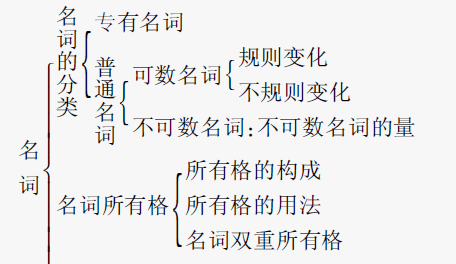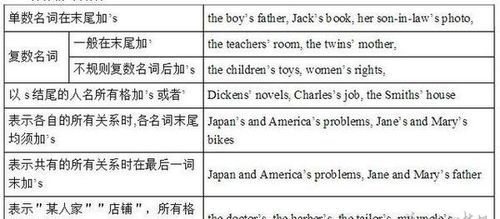本文目录
名词的英语语法思维导图
关于名词的英语语法
1.可数名词

可数名词是指能计数事物名称的词,包括个体名词和集体名词,有单、复数形式。复数名词构成法如下:
以s,x,ch,sh结尾的名词加-es(除stomach)。
以辅音字母加y结尾的名词,要变y为-ies。但以元音字母加y结尾时直接加-s。
以f或fe结尾的名词须直接加-s的.,如:beliefs,roofs,proofs,gulfs,chiefs,safes,serfs。变f或fe为-ves的,如:knives,leaves,halves,wives,lives,thieves.wolves,shelves,loaves。注意handkerchief的复数可直接加-s。也可变f为-ves。
以o结尾直接加-s,如:zoos,pianos,kilos,photos,autos,radios。加-es,如:Negroes,heroes,potatoes。
复数不规则的名词,如:man—men,woman—women,foot—feet,goose—geese,ox—oxen,child—children,tooth—teeth等。
单复数形式一样的名词,如:Chinese,Japanese,sheep,deer,means,works等。
2.不可数名词
不可数名词一般没有单复数之分,它包括物质名词、抽象名词和专有名词。
以-ics结尾的表示学科名称的名词一般用做单数。
某些以-s结尾的表示单一事物的专有名词常用做单数。
3.名词的所有格
(1) “’s”所有格。一般名词后加“’s”。如:Tom’s brother’s bag。
以-s或-es结尾的复数名词,在名词右上方加“’”。如:the workers’organization。
以-s结尾的专有名词所有格,若以读音[Z]结尾,一般可在名词右上方加“’”,也可加“’s”。如:Dickens’/Dickens’s cup。
如果一样东西为两个人共有,则只有后一个名词加“’s”;如果不是共有的,两个名词后都要加“’s”。如:Tom and Mary’s room(共有);Mary’s and Tom’s cups(不共有)。
(2) 表示无生命东西的名词,通常采用of+名词的结构来表示所有关系,总的来讲of所有格是’s所有格的一种替换形式。如:the class—room of the school。
(3) 表示时间、距离、国家、城市、团体、机构等无生命东西的名词,也可以加“’s”来构成所有格。如:today’s newspaper。
;英语名词知识点归纳思维导图
名词(n.):表示人、事物或抽象概念的名称的词。 名词分为普通名词和专有名词,其中普通名词包括可数名词和不可数名词,可数名词可用作单数,也可用作复数。
扩展资料
知识归纳:

1.可数名词包括个体名词(表示一类人或物的个体。如:boy,desk,cat,window)和集体名词(由若干个体组成的集合体。如:family,class,police)。
2.不可数名词包括物质名词(表示无法分为个体的实物。如:water,paper,silk,money)和抽象名词(表示性质、行为、状态、感情或其它抽象概念。如:work,happiness,music,difficulty,housework)
专有名词表示个人、地方、机构、组织等。如:Tom,the Great Wall,the Spring Festival,France,the United States。
3.有生命的`名词所有格以及表示时间、距离、城镇、国家等的名词所有格。
①不是以s结尾的名词变成所有格时,在词尾加’s.eg.Mike’s watch;Women’s Day
②以s结尾的名词变成所有格时,只加’。eg.teachers’office,students’rooms
③两个或两个以上名词并列,表示共同所有,只需在最后一个名词后加’s.eg.Tom and Mike’s room汤姆和迈克的房间(表示汤姆和迈克共有一间房)
④两个或两个以上名词并列,表示分别所有,需在几个名词后都加’s.eg.Mary’s and Jenny’s bikes玛丽和詹妮的自行车(表示玛丽和詹妮各自的自行车)
4.无生命的事物的名词所有格常用of结构eg.a map Of China,the beginning Of this game,the door Of the room
初高中英语语法知识点整理总结
一.定义:表示物体名称的单词;
二.分类:可数名词和不可数名词;
1.可数名词: 可以直接用数词来计量的名词;可数名词有单复数之分;
(1)可数名词的计数: 即可用数次,限定词(some/many/a lot of/few/a few等)来计数,也可用量词来计数;
e.g. three apples
the first prize
twenty days
some/ many books
a basket of apples
three boxes of books
(2)可数名词单复数转换规则:
①通常情况下,直接加“s”;
student—students
book—books
tree—trees
②以s, x, ch, sh结尾的名词加“es”;
glass—glasses
box—boxes
brush—brushes
match—matches
③以辅音字母加“y”结尾的名词,变“y”为“i”加“es”;
city—cities
baby—babies
enemy—enemies
④以“f”或“fe”结尾的名词,多数变“f”或“fe”为“v”加“es”(注意:roof, proof, chief 加s);
wife—wives
knife—knives
leaf—leaves
⑤以“o”结尾的名词,有的加“es”(hero,tomato, potato, cargo, echo);有的加“s”(radio, kilo, auto,
zoo, piano, photo, bamboo)。有生命的加“es”,无生命的加“s”。
⑥常见不规则变法名词:
foot—feet
goose—geese
tooth—teeth
child—children
man—men
woman—women
sheep—sheep
deer—deer
mouse—mice
sheep—sheep
fish—fish
deer—deer
2.不可数名词:不可以直接用数次来计数的名词;不可数名词本身没有单复数之分,不能变复数;不可数名词相当于可数名词单数的用法;
(1)不可数名词的计数:不可以用数次直接修饰,但可以用限定词(some/ much/ a lot of/little/ a little等)和量词(piece/cup/ bag等)来计数;
e.g. some water
a little juice
a cup of tea
three bottles of water
3.名词所有格:意为“……的”,相当于形容词性物主代词的用法,相当于形容词,用来修饰名词;
名词所有格的变换规则:
(1)名词不以“-s”结尾的,直接在名词右上角打“’”,加“-s”;
e.g. Tom———Tom’s
a student———a student’s
(2)名词以“-s”结尾的,直接在名词右上角打“’”即可。
e.g. many students———many students’ books
three days———three days’
(3)名词所有格的用法:
①表示两个人共有一个或多个物体,只需对后一个名词进行名词所有格,名词可以时单数,也可以时复数;
e.g. Tom and Li Ming’s room 汤姆和李明共同拥有的房间
Tom and Li Ming’s story books汤姆和李明共同拥有许多故事书
②表示两个人分别拥有物体时,需对每一个名词进行名词所有格,名词必须是复数;
e.g. Tom’s and Li Ming’s rooms汤姆和李明各自的房间
Tom’s and Li Ming’s story books汤姆和李明各有的许多故事书
③由数词修饰的名词所有格,如若数词超过“1”,需先把名词变为复数,在进行名词所有格;
e.g. three days’ holiday三天的假期
twenty minutes’ walk二十分钟的步行
4. 名词的特殊用法:
(1)名词充当形容词,作定语时,通常情况用单数;但man, woman要随着后面名词的单复数相应地变为单复数;
e.g. one girl student
three girl students
one man doctor
eight men doctors
(2)a picture/photo of sb指的是某人的一张照片,照片上的人就是本人;
a picture/photo of sb’s值得是某人的一张照片,照片上的人不一定是本人。
e.g. a photo of me我的一张照片(照片上的人是我)
a photo of Tom’s汤姆的一张照片(照片上的人不一定是汤姆)

高考语法填空名词考点
名词(Noun,简称n.),是词类的一种,属于实词 ,名词表示人、事物、地点或抽象概念的名称。以下是我为大家整理的名词的语法 总结 ,希望能帮助大家更好地认识名词,提高英语水平。
一、 名词主要考点:
1.特殊名词的单复数
2.与名词相关的主谓一致关系
二、 关于特殊名词的具体考点如下:
1.容易误用为复数的不可数名词:(这些名词一般不能用作复数,谓语动词用单数)
advice 建议,忠告 living 生活,生计
equipment 装备,设备 progress 前进,发展
furniture 家具,设备 scenery 风景,景色
information 通知;信息 machinery 机器,机械
knowledge 知识,学问 traffic 交通流量
baggage / luggage 行李,皮箱 trouble 烦恼,麻烦
cash 现金 thunder 雷声,轰隆声
apparatus 仪器 weather 天气,处境
clothing 衣服 work 工作,劳动
paper 纸,钞票 luck 运气,幸运
technology 工艺,技术 jewelry 珠宝
2. 复数形式的名词用于单数概念,其谓语动词用单数。(这些名词一般为表示学科或疾病的名词)
economics 经济学 measles 麻疹
physics 物理学 mumps 腮腺炎
mathematics 数学 rickets 软骨病,佝偻病
dynamics 动力学 news 新闻
The United States 美国 The New York Times 纽约时报
三、名词的主谓一致关系
英语中,主语和谓语在数、性和格上应该保持一致,但在实际应用中很容易被忽视,尤其是主语和谓语之间出现插入语,故考试中经常考到主谓一致。除了以上特殊名词谓语有特殊要求外,现将主谓一致的考点归纳如下:
1. 复数原则:两个或者两个以上的名词由and连接作主语时;主语由both … and … 连接时,谓语动词用复数。
Baseball and swimming are usually summer sports.
Both bread and butter are sold in that grocery. 那个杂货店既卖面包,也卖黄油。
2. 就近原则: 由 either … or … ; neither … nor …; not only…but also…; …or …; there be …等引导的主语, 谓语动词的单复数取决于最靠近动词的名词的单复数。
Not only the students but also their teacher is invited to attend the party.
3. 就远原则:主语,+ as well as +另一个主语,谓语动词的单复数取决于第一个主语的名词的单复数。
My mother, as well as my two brothers, has a key to the office.
我母亲,还有我的两个哥哥都有一把办公室的钥匙。
同例:with…; together with…; along with…; including…; in addition to…; besides …; except…; as much as…; accompanied by …; rather than…等等
4. 表示时间、距离、价值、量度的复数名词作主语时谓语动词用单数。
One hundred dollars is a large sum for the poor .
Twenty days have passed since I met her last time.
自从我上次见到她到现在已经过去二十天。 ( twenty days 这里不作整体看待, 故谓语动词用复数。)
5. and连接两个名词表示一个概念做主语时,谓语用单数; 若表示的是多个不同的概念时,谓语动词用复数。
War and peace is a constant theme in literature.
战争与和平是文学中永恒的主题。(War and peace是一对概念,看作一个主题)
同例: ham and eggs n.火腿蛋 steam and bread
law and order bread and butter
apple pie and ice cream folk and knife
wheel and axle 轮轴 needle and thread
love and hate egg and rice 蛋炒饭
The writer and translator is delivering a speech in our university tonight. (指同一个人)
The writer and the translator are delivering a speech in our university tonight. (指两个人)
A black and a white dog are playing in the yard. (指两只狗)
A black and white dog is playing in the yard. ( 指一只狗)
6.动词不定式、动名词、名词性从句做主语时+单数谓语
Early to bed and early to rise makes one healthy, wealthy and wise.
( 指“早睡早起”一件事)
To work hard is necessary
What I said and did is of no concern to you.
Reading three classical novels and making some social investigations are assignments for the students during the holiday. ( 注意: 指不同性质的两件事,谓语用复数 )
7. many a, more than one + 单数可数名词,尽管表示复数意义, 谓语仍用单数。
Many a student has made such a mistake.
More than one stranger agrees with me.
[注意]
在“more + 复数名词 + than one”结构作主语时,谓语动词用复数。
More persons than one have been involved. 卷入其中的远不止一人。
8. 由 every …and every …; each … and each…; no … and no…; many a …and many a … 等连接的并列主语,谓语动词用单数。
Every man and every woman working here is getting along well with me.
No difficulty and no hardship has discouraged him.
9. 由 all of, most of, half of , a lot of, part of 等加名词构成的主语,谓语动词的数取决于该名词的单复数。
All of us are going to see the game.
All of his time was spent on gambling
Three-fourths of the people are illiterate.
同例: plenty of…, one fourth of…, none of…, some of …, majority of …, … percent of …, the rest of …, reminder of …。
10. a number of ( a total of , an average of ) +复数名词,谓语动词用复数。
the number of ( the total of, the average of ) + 复数名词, 谓语动词用单数。
A total of ten thousand dollars were donated last month.
The total of dollars donated last month was 100,000 dollars.
同例: a / the variety of;a / the group of
11. 定语从句的谓语动词注意与先行词保持一致,但注意the only one of… 的用法。
One of those men likes to drive fast.
One of those men who like to drive fast is her son.
He is the only one of those men who likes to drive fast.
12. 由some,any, no,every 构成的复合词如somebody, nothing, nobody, anything, everybody等代词作主语,谓语动词用单数;由each, every one, no one, either, neither, another, the other作主语时,谓语动词用单数;由either, neither, each, every修饰名词作主语时,谓语动词用单数。如:
More than one example is necessary to make the students understand this rule clearly.
Neither is satisfactory.
Is either of the singers reading now?
13. the + adj / v-ed 表示一类人时, 用复数谓语动词; 表示抽象概念时, 谓语动词用单数。
The sick have been cured and the lost have been found.
病人得到了医治,失踪的也找回来了。
同例: the poor / dumb / innocent / guilty / unemployed / aged / oppressed / exploited…
We can do the difficult first. The impossible takes a little longer.
我们先从难题开始,不会的可能花的时间长一些。
The best is yet to come. 好戏还在后头。
14. a pair of + 由两部分物体构成的名词(如:shoes, scissors, glasses, jeans, pants, trousers)作主语时,谓语动词用单数。
My new pair of pants is being altered. 我的一条短裤正在修改。
15. 当主语被one ( a ) and a half 修饰时,谓语动词用数。
One and a half apples is left on the plate.
16. 当主语由 a series of…, a portion of …, a species of …, a kind of …, a sequence of …, a chain of…, a piece of … 加名词(单数或复数)构成时, 谓语用单数。
A series of lectures on psychology is said to be given by Mr. Li.
A large portion of her poems was published after her death.
--------------------------------------------------------------------------------------
相关 文章 推荐:
关于英语季节 名词的 用法与 语法
中考英语 语法 特辑--- 名词
practise 的用法详解
高中英语 语法 总复习动 名词 视频
graduate的用法说明
英语造句有哪些基本规则
英语 语法 学习难倒不少学生
influence的用法详解

以上就是关于名词的语法知识点 ,名词的英语语法思维导图的全部内容,以及名词的语法知识点 的相关内容,希望能够帮到您。
